Flexible solar panels are easy to fold, to fit over curved surfaces, and to install. On the surface, they seem like a great choice for any renewable-energy installation. But by going flexible, are you sacrificing efficiency for convenience?
Flexible solar panels tend to be less efficient and durable than ridged glass panels. However, their portability and easy installation nonetheless makes them a good charging option for when you’re on-the-go.
Below, we compare and contrast the different types of solar panels. We also discuss the pros and cons of flexible solar panels, which have much to offer under the right circumstances.

What Are Flexible Solar Panels
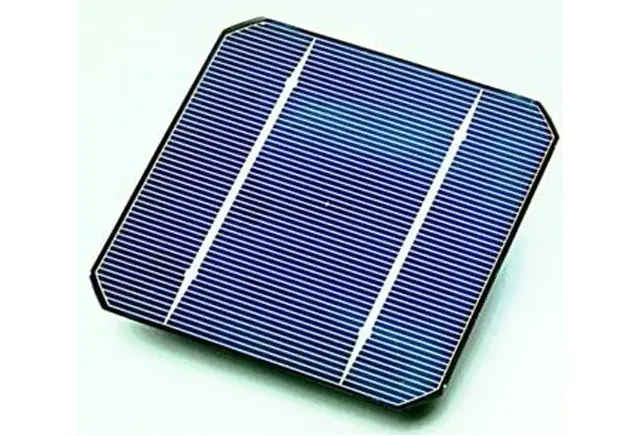
All solar panels are composed of solar cells that are photovoltaic, which refers to the electric current that’s generated when light touches two substances. These solar cells take the sun’s energy as it manifests in photons and converts it to electricity.
Let’s dive right into what flexible solar panels are and how they differ from traditional solar panels.
Materials Used
Flexible solar panels predominantly make use of thin-film technology. This technology uses photovoltaic material deposited in thin layers onto a flexible substrate, allowing the panels to bend and flex. The materials used in flexible solar panels come in three main types:
CIGS
“Copper Gallium Indium Diselenide” is the compound from which one type of thin-film solar cell is made. A conductive layer — which could be plastic, steel, glass, or aluminum — is placed both on top of and beneath the CIGS cells. Electrodes on both sides catch currents of electricity.
CdTe
The use of Cadmium Telluride or CdTe solar cells is more widespread than the other options. Here, the conducting layers placed both above and below the CdTe solar cells are transparent, helping to catch the light. In order to help protect the panel, an additional layer of glass is set on top.
a-Si
As the name suggests, amorphous silicon panels have the most in common with monocrystalline and polycrystalline panels. Just like the cells in those panels, a-Si solar cells use silicon. However, a-Si wafers are not made of crystalline silicon. They are instead composed of non-crystalline silicon that is set atop metal, glass, or plastic.
Now that you know about the materials used in flexible solar panels, let’s discuss the thin-film technology that sets them apart. In comparison to their rigid counterparts, flexible solar panels have several advantages:
- Lightweight: The thin nature of the photovoltaic material used in these panels allows for lower weight, which is particularly useful for rooftop solar systems, RVs, boats, and portable solar power solutions.
- Flexibility: As the name implies, flexible solar panels can bend to various degrees depending on the specific panel technology. This feature makes them adaptable to different surfaces and designs, making them particularly useful for curved or irregularly shaped surfaces.
- Ease of installation: Flexible solar panels are typically easier to install than traditional panels due to their lightweight nature and, in some cases, having adhesive or velcro backing.
Personal tips: While flexible solar panels offer some great advantages, it’s important to note that their overall solar energy efficiency is generally lower than that of traditional monocrystalline or polycrystalline solar panels.
History
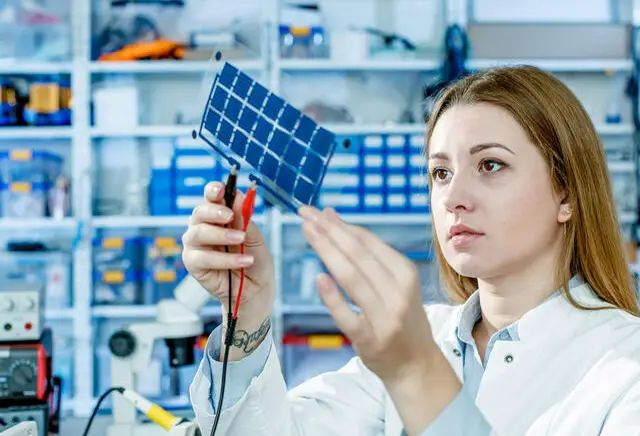
Thin-film solar panels have been around for over three decades. One of their first uses was powering solar calculators. These calculators included small quantities of a-Si or amorphous silicon.
Just before the turn of the 21st century, an Indian American scientist named Subhendu Guha, who had also previously worked with a-Si, helped invent flexible solar shingles.
Guha’s flexible solar shingles were installed directly on the roof of a house in place of typical asphalt shingles, where they absorbed the sunlight before converting it to electricity that powered the home.
Today, thin-film panels can be found in even grander schemes, from solar-powered farms to electric cars.
Furthermore, price of solar panels have drastically decreased over the recent years. The price of solar modules declined by 99.6% since 1976 (Source: Our World in Data).

How Do They Work?
The thinness of these wafers makes the panels themselves more flexible than either monocrystalline or polycrystalline panels. In fact, the layers in thin-film panels can be 300+ times smaller than the layers in customary panels that have silicon solar cells.
This is quite something when you consider that the average wafer in mono or polycrystalline solar cell has a thickness of roughly 200 micrometers (.0002 meters). That’s only a little bit thicker than one of the hairs on your head.
Flexible solar panels work much as other panels do: although their materials are different, they still catch the sunlight and convert it to electricity. They have the same dark — black or blue — coloring that’s optimized to absorb as much light as possible while the sun is out.
However, more traditional mono and poly solar panels tend to be bigger in both physical size and wattage. A typical (more rigid) solar-panel system that supplies the power for a house, for example, might have heftier panels that boast 340 watts of power each.
On the other hand, flexible solar panels tend to be lower wattage — generally 50-300 watts — while also being smaller.
Personal tips: If you’re looking to learn more about how solar panels work, I recommend checking this Classroom by Nationnal Geographic.
Efficiency and Power Generation
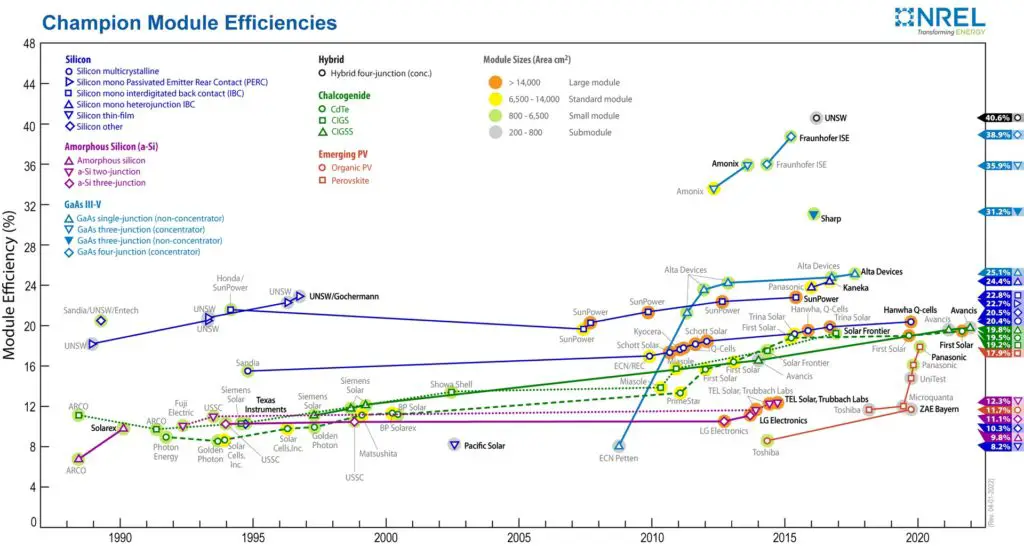
Now that you know a little more about each type of panel and its composition, the question is: how do these differences in materials and production affect each
Between Mono, Poly, & Flexible Solar Panels
Depending on the type you purchase, flexible solar panels can have an efficiency of roughly 7-13﹪.
But with the technology evolving, the difference in power generation is getting similar to rigid solar panels.
That’s several percentage points lower than poly panels and could be as much as half (or more) that of monocrystalline panels.
Because their efficiency is lower, you will need more of them to generate comparable energy.
This point is especially important when it comes to rooftop installation. Your roof may simply not be large enough to accommodate all the flexible solar panels that would be needed to power your home.
In general, it’s monocrystalline and polycrystalline solar panels that will generate more power per square footage (or per square meter).
Maximum Efficiency
Achieving maximum efficiency is an important goal when selecting a flexible
To make the most out of your flexible
Here’s a quick breakdown to help you remember the key differences:
- Thin-film panels: 10-12% efficiency, lightweight, adaptable
- Monocrystalline panels: Up to 20% efficiency, rigid, heavier
- SunPower flexible panels: Up to 22% efficiency
- Renogy flexible panels: Up to 21% efficiency
While efficiency is an important aspect of selecting a
Durability and Lifespan
When considering flexible solar panels, it’s essential to weigh their durability and lifespan against their more rigid counterparts. This section will explore the build quality, components, and factors that influence their ability to withstand the test of time.
Durability Factors

Flexible solar panels consist of various photovoltaic materials, usually incorporating thin layers of amorphous silicon. The manufacturing process plays a significant role in their overall durability. Key factors to consider include:
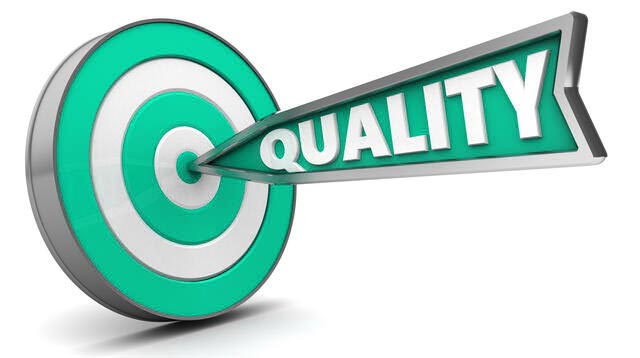
- Material Quality: The quality of amorphous silicon, other photovoltaic materials, and components like encapsulation materials, directly impact the panel’s resistance to wear and tear.
- Protective Coating: A durable outer protective layer shields the solar cells from weather-related damage and UV exposure, contributing to longevity.
- Mechanical Stress: Flexible solar panels need to withstand bending and flexing without cracking or compromising their performance. Keep this in mind while installing them on curved surfaces or objects prone to movement.
Related Articles:
– How do you clean flexible solar panels?
– Do flexible solar panels overheat?
Lifespan Comparison
As you evaluate the expected lifespan of flexible solar panels, remember it’s essential to compare them to other types of panels. Below is a quick comparison between flexible and traditional silicon solar panels:
| Panel Type | Average Lifespan |
|---|---|
| Flexible Solar Panels | 10-15 years |
| Traditional Solar Panels | 25-30 years |
While flexible solar panels may not have as long a lifespan as rigid panels, they offer unique advantages such as lighter weight, easier installation, and adaptability to a broader range of applications.
Maintaining your flexible solar panels – by performing regular visual inspections and keeping them debris-free – will ensure you get the most out of them during their lifespan. Remember to factor in the initial cost and potential replacement costs when making your decision about the type of
What Are the Advantages and Disadvantages of Flexible Solar Panels?

That being said, it’s important to remember that efficiency is not the lone criterion to consider when it comes to solar panels in general and flexible solar panels in particular.
There are several benefits that flexible panels offer:
 Lightweight. Because they are thin, flexible solar panels are not as heavy as comparatively bulkier mono and polycrystalline panels.
Lightweight. Because they are thin, flexible solar panels are not as heavy as comparatively bulkier mono and polycrystalline panels.
Although space is a significant issue when it comes to rooftop installation, flexible solar panels can still be a good choice for smaller roofs or roofs that can’t bear the weight of mono and poly solar panels. That’s where lightweight, flexible solar panels could come in handy.
 Portable. The panels’ lighter weight also makes it easy to cart around. Additionally, you can fold and store them without difficulty because they are so flexible. For on-the-go charging needs, flexible solar panels are worth considering.
Portable. The panels’ lighter weight also makes it easy to cart around. Additionally, you can fold and store them without difficulty because they are so flexible. For on-the-go charging needs, flexible solar panels are worth considering.
 Inexpensive. Flexible solar panels are among the most affordable panels available. For one thing, you don’t need as much material to make them, which means they’re cheaper to make, and consequently less expensive for you to buy. Consider that you can currently purchase a flexible
Inexpensive. Flexible solar panels are among the most affordable panels available. For one thing, you don’t need as much material to make them, which means they’re cheaper to make, and consequently less expensive for you to buy. Consider that you can currently purchase a flexible solar panel with 100 watts of power for $100.
 Easy Installation. For another thing, the panels’ lightness and portability make them relatively easy to install as well. If you aren’t planning on doing the work yourself, you could potentially cut down on labor and installation costs by choosing flexible panels.
Easy Installation. For another thing, the panels’ lightness and portability make them relatively easy to install as well. If you aren’t planning on doing the work yourself, you could potentially cut down on labor and installation costs by choosing flexible panels.
 Versatile. These panels’ flexibility means they’re well suited for curved or oddly shaped structures. They can be manipulated to fit different surfaces, making them a worthy option for unconventional or atypical installations.
Versatile. These panels’ flexibility means they’re well suited for curved or oddly shaped structures. They can be manipulated to fit different surfaces, making them a worthy option for unconventional or atypical installations.
Related Article:
– Are Flexible Solar Panels Worth It?
It’s interesting to note that while many consider it a disadvantage that flexible solar panels take up so much space, this is not always an issue. Many of the globe’s biggest solar-powered farms utilize thin-film cells.
However, there are also a few other disadvantages to keep in mind:
 Less durable. The same thinness that makes flexible solar panels so light and flexible also renders them less hardy, particularly as the years go on. Some lack a layer of glass on top and are not framed with metal (which would inhibit their flexibility). Over time, flexible panels are subject to more strain since they are affixed to supple sheets. Wiring issues can occur, and the solar cells can break.
Less durable. The same thinness that makes flexible solar panels so light and flexible also renders them less hardy, particularly as the years go on. Some lack a layer of glass on top and are not framed with metal (which would inhibit their flexibility). Over time, flexible panels are subject to more strain since they are affixed to supple sheets. Wiring issues can occur, and the solar cells can break.
 Shorter warranties. What this means is that flexible solar panels tend to have shorter lifespans than mono or polycrystalline panels. You will see this fact reflected in the shorter warranties (around 2-5 years) that manufacturers may include for both the panels’ materials and power.
Shorter warranties. What this means is that flexible solar panels tend to have shorter lifespans than mono or polycrystalline panels. You will see this fact reflected in the shorter warranties (around 2-5 years) that manufacturers may include for both the panels’ materials and power.
What Are Flexible Solar Panels Best Suited For?

When it comes to home rooftop installations, either mono or polycrystalline panels will likely be your best bet. If you have the budget, it may be worth spending the extra money on monocrystalline panels so you can benefit from their efficiency. Polycrystalline panels cost less but keep in mind that you will need more of them.
While flexible solar panels may not be the most efficient choice for your home’s rooftop, they are still a great option for any of the following:
- Boating. Their portability makes flexible solar panels ideal for many outdoor activities. Instead of a generator that makes a lot of noise, try powering your boat with solar energy. The panels can be used for smaller fishing boats as well as yachts. There are even flexible solar panels made, especially for marine ventures.
- Camping. Flexible solar panels also make for excellent power banks for your tent. They’re easy to fold and pack and then to store away when you don’t need them. Retailers will often list them as camping panels.
- RV-ing. Flexible panels are good options for portable solar-power systems in general, and installing them on RVs is one popular example. The installation is simple, cost-effective, and of course, eco-friendly.
- On-the-go charging. Even if you don’t own an RV, you could still install a flexible panel system on the roof of your car. It won’t power the vehicle, but you could use it to charge your phone or other electronics whenever and wherever you might be traveling.
Related Guides:
– Attaching flexible solar panels to van roof
– Best adhesives for flexible solar panels
What Should I Look for in a Flexible Solar Panel ?
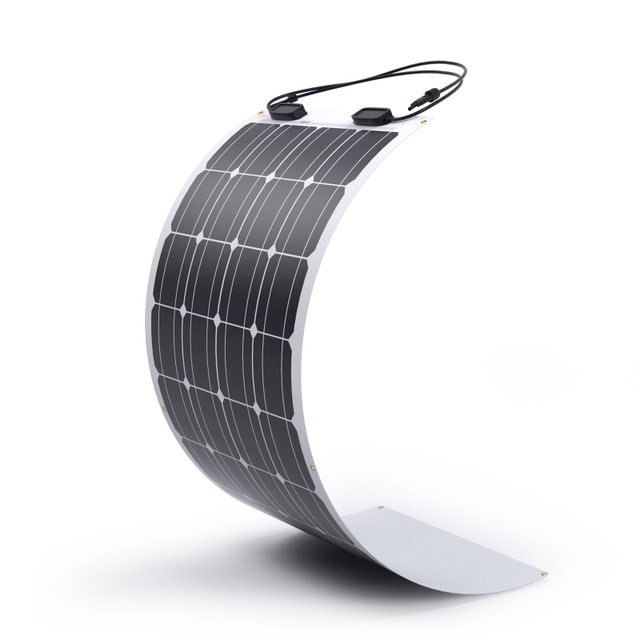
If you do decide that flexible solar panels are what you’re looking for, you will want to keep several things in mind while shopping for the right ones.
- Wattage. The amount of power that a flexible
solar panel can generate will be stated in wattage on the packaging. The higher the wattage, the more devices thesolar panel can charge, and/or the more powerful the vehicle it can power.
If you’re looking for a panel to charge your boat for a few hours, for example, a flexible
- Weight. You will usually find that flexible solar panels fall within a short-range when it comes to weight: between 4 and 8lbs. (1.81-3.62kg).
- Angle. Not every flexible
solar panel will bend at the same angle. However, 30° is fairly standard.
- Warranty. Generally speaking, a longer warranty indicates a quality, durable product. But since flexible solar panels are not as long-lasting as their mono and polycrystalline
solar panel counterparts, you’ll find that their warranties are shorter: often in the range of 2-5 years (although that can vary, depending on the product). Some warranty, however, of at least a few years should be included.
- Installation guide. It is typically a good sign if a manufacturer has included an installation guide along with the panels. There’s some debate as to whether an installation guide is even necessary for flexible solar panels since the panels can be so simple to install — in the case of some RV installations, you can just use Velcro!
But a thorough manual indicates the company cares that you install their panels correctly. This is a sign that the company cares about its products, which usually means the products are of higher quality.
- Certifications. Your flexible solar panels should come with industry certifications that prove the panels have met a baseline standard for quality. Look for ISO 9001 or the certification IEC 61215.
- Polymers. You will also want to keep an eye out for the types of polymers used in your flexible solar panels.
A polymer layer is placed both on top of and beneath the solar cells in a flexible panel. The polymer PET (Polyethylene Terephthalate) is used in lower-quality panels. What you want to see instead is the polymer ETFE (Ethylene Tetrafluoroethylene) listed on the panel.
Among other things, ETFE is more durable. This is certainly something you want to keep in mind if you are buying flexible solar panels to power outdoor activities where the elements will be a factor.
For more information about flexible solar panels, check out this great video made by Will Prowse
Conclusion
Ultimately, flexible solar panels are not the most efficient solar panels that are currently on the market.
Their typical efficiency of 7-13﹪ falls below Polycrystalline panels’ 16-17﹪ efficiency and well behind Monocrystalline panels’ roughly 20﹪ efficiency.
However, it would be a mistake to discount flexible solar panels entirely. They are often the best choice for outdoor and on-the-go charging needs, including boat and RV installations. Often, they are the best choice for commercial roofing as well.
Although it is an important factor, efficiency is not the only detail to consider when selecting the right
Frequently Asked Questions
Flexible solar panels are an innovative technology that has piqued the interest of many. Here are a few frequently asked questions to help you better understand their efficiency and application.
How do flexible solar panels differ from traditional solar panels in terms of efficiency?
Flexible solar panels are generally less efficient than traditional solar panels, primarily because they use thinner layers of solar cells. However, their ability to be installed on unconventional surfaces and adapt to various angles can make up for this difference in certain situations.
Can flexible solar panels still work in the shade?
Like any
How long do flexible solar panels last?
The lifespan of flexible solar panels is typically shorter than that of traditional panels, lasting around 10-15 years as opposed to 20-25 years. However, advancements in technology are steadily increasing their durability, so you can expect improvements in this area over time.
Can I walk on flexible solar panels?
Some flexible solar panels are designed to withstand light foot traffic, making them suitable for installation on areas like boat decks or RV rooftops. Nonetheless, it’s essential to check the specific product guidelines before attempting to walk on your panels.
